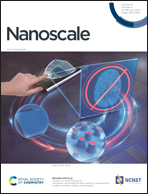Observation of different Li intercalation states and local doping in epitaxial mono- and bilayer graphene on SiC(0001)†
Abstract
Li intercalation is commonly used to enhance the carrier density in epitaxial graphene and mitigate coupling to the substrate. So far, the understanding of the intercalation process, particularly how Li penetrates different layers above the substrate, and its impact on electron transport remains incomplete. Here, we report different phases of Li intercalation and their kinetic processes in epitaxial mono- and bilayer graphene grown on SiC. The distinct doping effects of each intercalation phase are characterized using scanning tunneling spectroscopy. Furthermore, changes in the local conduction regimes are directly mapped by scanning tunneling potentiometry and attributed to different charge transfer states of the intercalated Li. The stable intercalation marked by the formation of Li–Si bonds leads to a significant 56% reduction in sheet resistance of the resulting quasi-free bilayer graphene, as compared to the pristine monolayer graphene.



 Please wait while we load your content...
Please wait while we load your content...